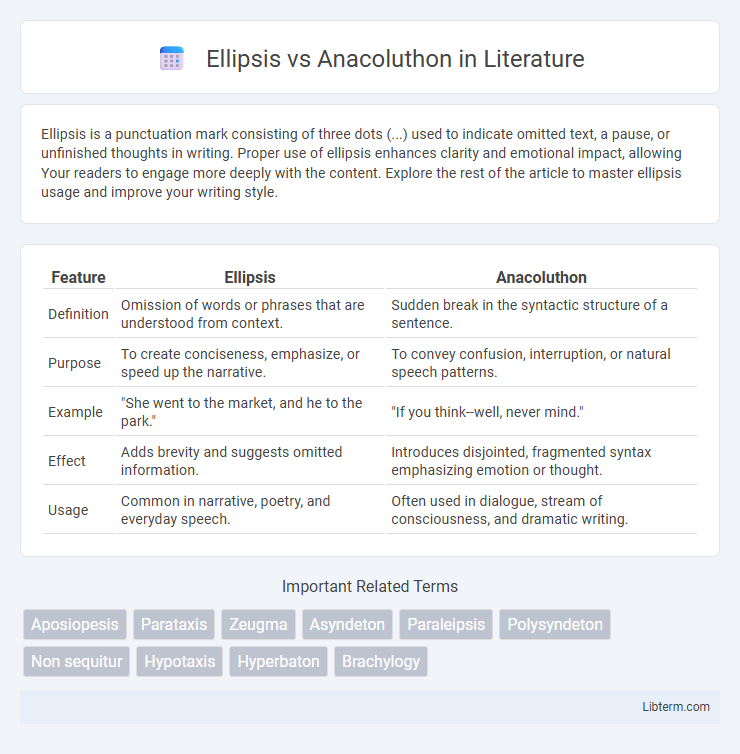Ellipsis is a punctuation mark consisting of three dots (...) used to indicate omitted text, a pause, or unfinished thoughts in writing. Proper use of ellipsis enhances clarity and emotional impact, allowing Your readers to engage more deeply with the content. Explore the rest of the article to master ellipsis usage and improve your writing style.
Table of Comparison
| Feature | Ellipsis | Anacoluthon |
|---|---|---|
| Definition | Omission of words or phrases that are understood from context. | Sudden break in the syntactic structure of a sentence. |
| Purpose | To create conciseness, emphasize, or speed up the narrative. | To convey confusion, interruption, or natural speech patterns. |
| Example | "She went to the market, and he to the park." | "If you think--well, never mind." |
| Effect | Adds brevity and suggests omitted information. | Introduces disjointed, fragmented syntax emphasizing emotion or thought. |
| Usage | Common in narrative, poetry, and everyday speech. | Often used in dialogue, stream of consciousness, and dramatic writing. |
Understanding Ellipsis: Definition and Usage
Ellipsis is a linguistic device that involves the intentional omission of words or phrases that are implied by the context, allowing for concise and efficient communication. Common in both spoken and written language, ellipsis enhances fluency by avoiding redundancy while maintaining clarity, such as in the sentence "She can play the guitar, and he can too," where "play the guitar" is omitted after "he can." Understanding ellipsis is crucial for interpreting meaning accurately, especially in conversational contexts or literary texts where implied content drives narrative flow and reader engagement.
Defining Anacoluthon: A Syntactic Disruption
Anacoluthon is a syntactic disruption where the expected grammatical sequence in a sentence is abruptly broken, leading to an incomplete or disjointed structure. Unlike ellipsis, which omits elements for brevity while maintaining coherence, anacoluthon creates a jarring effect by shifting sentence patterns mid-thought. This rhetorical device reflects natural speech patterns or emphasizes emotional intensity through its unexpected breaks.
Grammatical Structure: Ellipsis vs Anacoluthon
Ellipsis involves the intentional omission of one or more words that are understood from the context, maintaining grammatical completeness despite missing elements. Anacoluthon disrupts the expected grammatical structure by abruptly changing the sentence pattern, resulting in a syntactic break or incoherence. While ellipsis preserves semantic clarity within a coherent framework, anacoluthon creates a stylistic interruption that challenges traditional grammatical expectations.
Stylistic Effects in Writing
Ellipsis creates concise, impactful writing by omitting words that are implied, enhancing reader engagement through inference and rhythm. Anacoluthon disrupts sentence structure unexpectedly, generating a sense of spontaneity or emotional intensity that reflects natural speech patterns. Both techniques manipulate syntax to emphasize meaning and evoke specific stylistic effects, enriching narrative voice and tone.
Common Examples of Ellipsis
Ellipsis is frequently used in everyday conversations and literature to omit words that are implied, such as in the question-and-answer pair, "Want some coffee?" followed by "I already have," where the verb phrase "have some coffee" is omitted. In comparative statements like "She can play the guitar; he, the piano," ellipsis removes the repeated verb for brevity and clarity. These examples illustrate how ellipsis enhances communication efficiency by relying on context to fill in missing information, contrasting with anacoluthon, which involves a sudden break in sentence structure.
Famous Cases of Anacoluthon
Anacoluthon, a sudden break in sentence structure, appears prominently in James Joyce's "Ulysses," where it reflects the disrupted thought patterns of characters, enhancing narrative realism. T.S. Eliot's poem "The Waste Land" also employs anacoluthon to convey fragmented modernist themes and emotional disarray. These famous cases illustrate anacoluthon's power to mirror psychological complexity, contrasting with ellipsis, which typically omits elements for conciseness and fluidity.
Ellipsis in Literature and Everyday Speech
Ellipsis, a linguistic device characterized by the deliberate omission of words, enhances conciseness and engages readers in literature by inviting them to infer missing elements, thereby enriching narrative depth. Commonly used in everyday speech, ellipsis facilitates efficient communication by omitting redundant information while maintaining clarity and context. Contrastingly, anacoluthon disrupts sentence structure, creating syntactic interruptions that reflect natural speech patterns or convey emotional intensity.
Anacoluthon as a Rhetorical Device
Anacoluthon is a rhetorical device characterized by a sudden break in the syntactic structure of a sentence, creating disruption that emphasizes an emotional or dramatic effect. Unlike ellipsis, which involves the intentional omission of words for conciseness, anacoluthon deliberately abandons grammatical coherence to reflect confusion, urgency, or a shift in thought. This technique is often used in literature and speeches to convey a character's agitation or to mimic natural speech patterns, enhancing the expressive power of the discourse.
Clarifying Ambiguity: When to Use Each
Ellipsis removes unnecessary words to streamline sentences and clarify meaning, especially when context makes the omitted elements obvious, reducing ambiguity. Anacoluthon, a break in sentence structure, intentionally introduces ambiguity or reflects natural speech patterns, often used in literature or dialogue to convey confusion or emotional disruption. Choosing ellipsis enhances clarity and conciseness, while anacoluthon highlights a speaker's thought process or emotional state, making it suitable when ambiguity or emphasis on interruption is desired.
Choosing Between Ellipsis and Anacoluthon
Choosing between ellipsis and anacoluthon depends on the intended effect and clarity of the sentence. Ellipsis omits words that are implied by context, enhancing brevity and maintaining grammatical coherence, while anacoluthon involves a sudden break or shift in the sentence structure, often creating emphasis or reflecting thought disruption. Writers prioritize ellipsis for concise communication and opt for anacoluthon to convey spontaneous speech or stylistic fragmentation.
Ellipsis Infographic

 libterm.com
libterm.com